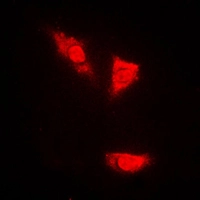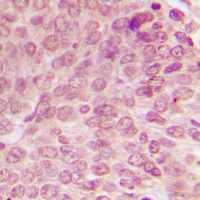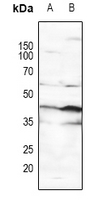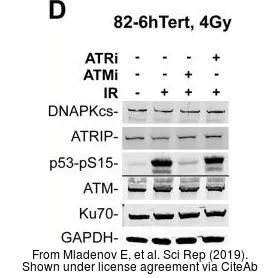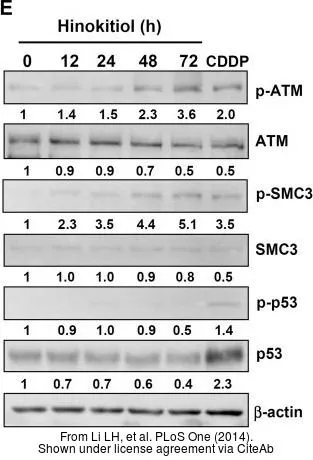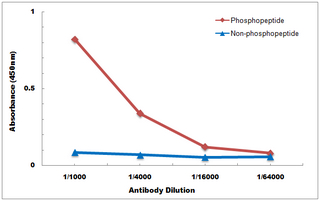
ELISA analysis of phospho- and non phosho- peptide using GTX21431 p53 (phospho Ser15) antibody. Red : Phosphopeptide Blue :Non-phosphopeptide Dilution : 5 microg/ml
p53 (phospho Ser15) antibody
GTX21431
ApplicationsImmunoFluorescence, ImmunoPrecipitation, Western Blot, ELISA, ImmunoCytoChemistry, ImmunoHistoChemistry, ImmunoHistoChemistry Paraffin
Product group Antibodies
ReactivityHuman, Mouse, Rat
TargetTP53
Overview
- SupplierGeneTex
- Product Namep53 (phospho Ser15) antibody
- Delivery Days Customer9
- Antibody SpecificityThe phospho-p53 (Ser15) antibody detects ~53 kDa phosphorylated p53 at Ser15. It does not react with non-phosphorylated p53 or p53 phosphorylated at other sites.
- ApplicationsImmunoFluorescence, ImmunoPrecipitation, Western Blot, ELISA, ImmunoCytoChemistry, ImmunoHistoChemistry, ImmunoHistoChemistry Paraffin
- CertificationResearch Use Only
- ClonalityPolyclonal
- Concentration0.5 mg/ml
- ConjugateUnconjugated
- Gene ID7157
- Target nameTP53
- Target descriptiontumor protein p53
- Target synonymsantigen NY-CO-13; BCC7; BMFS5; cellular tumor antigen p53; LFS1; mutant tumor protein 53; P53; p53 tumor suppressor; phosphoprotein p53; transformation-related protein 53; TRP53; tumor protein 53; tumor supressor p53
- HostRabbit
- IsotypeIgG
- Protein IDP04637
- Protein NameCellular tumor antigen p53
- Scientific DescriptionThe p53 tumor suppressor protein plays a major role in cellular response to DNA damage and other genomic aberrations. The activation of p53 can lead to either cell cycle arrest and DNA repair or apoptosis. p53 is phosphorylated at multiple sites in vivo and by several different protein kinases in vitro. p53 can apparently be phosphorylated by ATM, ATR, and DNA-PK at Ser15; the phosphorylation impairs the ability of MDM2 to bind p53, promoting both the accumulation and functional activation of p53 in response to DNA damage.
- ReactivityHuman, Mouse, Rat
- Storage Instruction-20°C or -80°C,2°C to 8°C
- UNSPSC12352203
References
- Loss of fragile WWOX gene leads to senescence escape and genome instability.Read more
- Radiation-dose-dependent functional synergisms between ATM, ATR and DNA-PKcs in checkpoint control and resection in G2-phase. Mladenov E et al., 2019 Jun 4, Sci RepRead more
- Nano-Diamino-Tetrac (NDAT) Enhances Resveratrol-Induced Antiproliferation by Action on the RRM2 Pathway in Colorectal Cancers. Nana AW et al., 2018 Oct, Horm CancerRead more
- Resveratrol induces sumoylated COX-2-dependent anti-proliferation in human prostate cancer LNCaP cells. Cheng TM et al., 2018 Feb, Food Chem ToxicolRead more
- Hinokitiol induces DNA damage and autophagy followed by cell cycle arrest and senescence in gefitinib-resistant lung adenocarcinoma cells. Li LH et al., 2014, PLoS OneRead more
- Neem leaf extract inhibits mammary carcinogenesis by altering cell proliferation, apoptosis, and angiogenesis. Arumugam A et al., 2014 Jan, Cancer Biol TherRead more
- PLRG1 is an essential regulator of cell proliferation and apoptosis during vertebrate development and tissue homeostasis. Kleinridders A et al., 2009 Jun, Mol Cell BiolRead more

